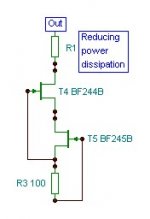If we use J-fet with lower Vgs(off) and lower output conductance we gain in line rejection as well as HF performance.
aparatusonitus,
well, 2SK170 has higher Gm, which means higher capacitances. To significantly increase the dynamic impedance, bandwidth and overall linearity I use cascodes (for instance BF244/245), very good performance with just three parts.
well, 2SK170 has higher Gm, which means higher capacitances. To significantly increase the dynamic impedance, bandwidth and overall linearity I use cascodes (for instance BF244/245), very good performance with just three parts.
You are right about cascoding two J-fet, that's is the one way to get high output impedance, but one might try BJT+ J-fet cascode (such as in Steven circuit http://www.diyaudio.com/forums/attachment.php?s=&postid=330449&stamp=1077312778 or somewhat different configuration from recent Walt Jung's article about CCS). About your suggestion for BF244/245 cascoded J-fet CCS - this two devices look identical (if I remember datasheet correctly), so if that is the case, wouldn't be better to use e.g. BF244A and on top of it an BF244B/C for cascode devices?
aparatusonitus,
JFETs have excellent properties for CCS, you won`t find anything better.
BF244 and BF245 are different. In absence of various types, for a wider range of current, please go for BF244B or C as the cascoding (top) device, any other type would work as the cascoded (bottom) one.
JFETs have excellent properties for CCS, you won`t find anything better.
BF244 and BF245 are different. In absence of various types, for a wider range of current, please go for BF244B or C as the cascoding (top) device, any other type would work as the cascoded (bottom) one.
Lumba Ogir said:aparatusonitus,
JFETs have excellent properties for CCS, you won`t find anything better.
Lumba,
Please tell us more about thermal behavior, how stable is a current source based on jfets? 😉
Regards,
Mihai
Thanks for the tips Lumba, I'll cerefully study W. Jung article more as well as an old Siliconix application note about J-fet CCS.
roender,
in general: they are very sensitive, consequently, easily develop thermal distortions, therefore and for every reason should always be cascoded in common-source configuration, anyway.
As CCS: no difference, however, the advantages are massive, high dynamic impedance, wide bandwidth, fairly low noise, elegant clean biasing.
in general: they are very sensitive, consequently, easily develop thermal distortions, therefore and for every reason should always be cascoded in common-source configuration, anyway.
As CCS: no difference, however, the advantages are massive, high dynamic impedance, wide bandwidth, fairly low noise, elegant clean biasing.
Attachments
Lumba,
After many practical experiments, I've come to conclusion that the best CCS, from noise, impedance, thermal stability and precision POV (all of this into a balanced blend), is the combination between a LED and a low noise BJT, cascoded with another BJT with low Cob.
The trick here is to properly use the cascoded transistor, to not turn the whole thing into a oscillator😉
Cheers,
Mihai
After many practical experiments, I've come to conclusion that the best CCS, from noise, impedance, thermal stability and precision POV (all of this into a balanced blend), is the combination between a LED and a low noise BJT, cascoded with another BJT with low Cob.
The trick here is to properly use the cascoded transistor, to not turn the whole thing into a oscillator😉
Cheers,
Mihai
roender said:The trick here is to properly use the cascoded transistor, to not turn the whole thing into a oscillator😉
Base resistor on cascode transistor?
aparatusonitus said:
Base resistor on cascode transistor?
Yes, among many other things, like PCB design and type of cascode bias source
roender said:Try something with not so low Zout ...
But then we wouldn't need a base stopper, right?
aparatusonitus said:
But then we wouldn't need a base stopper, right?
Depends ... those things are dependent on PCB layout
Mihail,
Do you have any experience with simple Vbe multiplier as voltage reference? Would you consider it as a low output impedance voltage reference?
Do you have any experience with simple Vbe multiplier as voltage reference? Would you consider it as a low output impedance voltage reference?
aparatusonitus said:Mihail,
Do you have any experience with simple Vbe multiplier as voltage reference? Would you consider it as a low output impedance voltage reference?
Sorry, no experience, never try that.
roender,
your circuit does not constitute as high impedance, the biasing makes a ripple injection into the base and the LED adds noise. You could disclose it without losing anything. Predictably, it cannot beat the JFET CCS neither functionally nor sonically.
your circuit does not constitute as high impedance, the biasing makes a ripple injection into the base and the LED adds noise. You could disclose it without losing anything. Predictably, it cannot beat the JFET CCS neither functionally nor sonically.
Lumba Ogir said:roender,
your circuit does not constitute as high impedance, the biasing makes a ripple injection into the base and the LED adds noise. You could disclose it without losing anything. Predictably, it cannot beat the JFET CCS neither functionally nor sonically.
A cascoded CCS is a very high impedance circuit.
What do you know about my biasing methods? Do you know how much noise a LED can produce?
Blow some air through a j-fet CCS and watch at the output current 😀 .
For circuits where VAS current give the bias for the output stage, this type of CCS is a total desaster, not to mention about OLG variation with temperature ...
Don't get me wrong, I'm a big fan of j-fets, but not as a CCSs ... with only one exception, when is used as a current source for LED biasing
- Status
- Not open for further replies.
- Home
- Amplifiers
- Headphone Systems
- Folded cascode headphone amp
